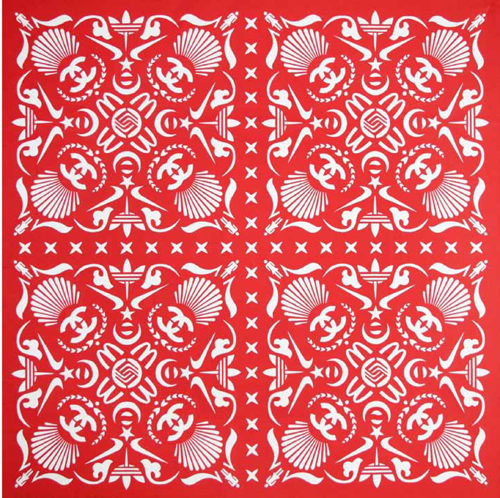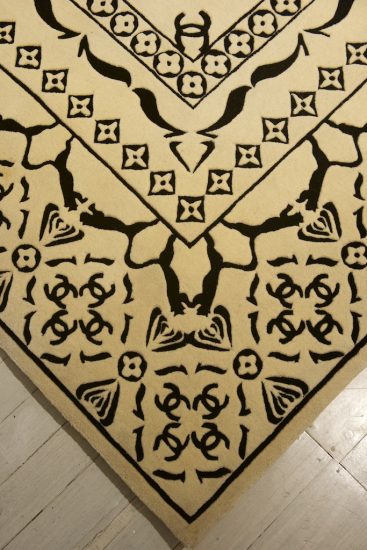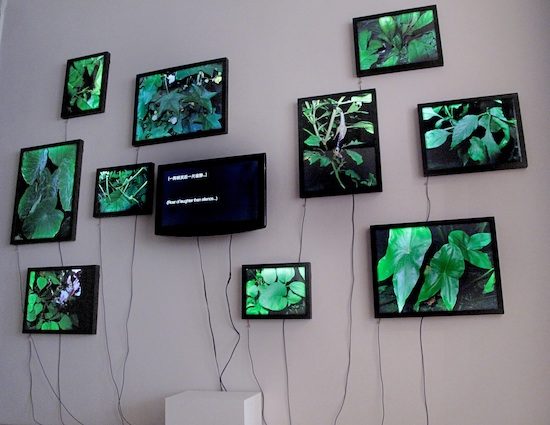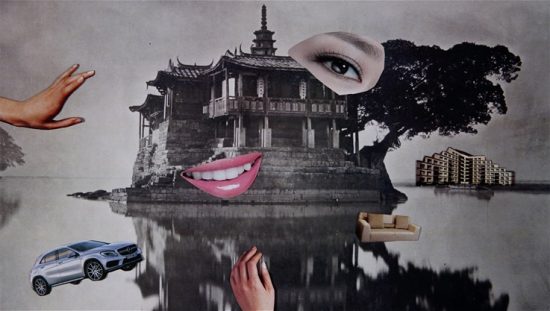Luise Guest on Chen Hangfeng’s interest on the impact of globalisation on Chinese art and culture, consumerism and cultural exchange…
Chen Hangfeng’s witty LOGOMANIA series of papercuts and woven carpets featuring the all-too-recognisable visual branding of multinational corporations has been shown several times in Sydney at White Rabbit Gallery. Trained as a designer, LOGOMANIA was Chen’s first body of work as he began to position himself as a contemporary artist rather than as a designer; it reveals his continuing interest in how Chinese society has been transformed by the rule of new ‘emperors’ in the form of powerful global corporations whose brands have changed the face of Chinese cities and impacted the life of every citizen.

Chen describes them as a ‘kingdom of brands’ akin to the socialist propaganda of earlier times. He says they are ‘almost as powerful as political machines – maybe even more powerful!’ His work explores overconsumption, waste, greed and the power of advertising, as powerful in directing people’s behaviour and desires as the propaganda posters that glorified the revolution in the twentieth century. Chen’s papercuts at first resemble traditional intricate designs – until you look closely and see the Nike ‘swoosh’, the McDonalds ‘M’ and the logos of luxury brands from Puma and Adidas to Louis Vuitton, Chanel and Mercedes Benz.

Emerging out of this project, Chen’s fascination with the concept of ‘invasive species’, whether literal (he has worked on art projects about the Chinese carp, and Japanese knockweed) or metaphorical (the worldwide proliferation of American fast food) continues. Invasive Species: Vegetables(2010) is a witty installation of photographs on lightboxes in which the characters of the mythological ‘Eight Immortals’ are played by vegetables engaged in a raunchy conversation in a Shanghai communal garden of the kind that city officials had declared to be illegal. Each box lights up in turn as the vegetables ‘speak’. Like many of Chen’s deceptively simple works, Invasive Species: Vegetablesreferences ancient Chinese traditional tales, the bawdiness of Shanghainese theatrical traditions, and courageously stubborn acts of civil disobedience of in the face of officialdom.

In April this year I returned to Shanghai to speak with Chen Hangfeng about the latest developments in his practice and a new video work called Excited with No Reason(2018). Since we last met in 2015 Chen has established a studio in the Netherlands and now divides his time between Shanghai and Amsterdam. As a result, he has become fascinated by the history of transnational capital; colonial conquest; the travel of commodities such as porcelain and tea between China and Europe, and the impact of this trade on geopolitics. The animation Excited with No Reason delves into this territory with wit and visual acuity. Critic and curator Rebecca Catching described it as an ‘exploration of the modernist concept of time—bolstered by its henchmen of capital and scientific rationalism—which promise a harmonious trajectory from chaos to utopia.’
This jittery animated collage references ink painting, traditional gods and immortals, and traded commodities both ancient and modern, from porcelain and endangered bird species to cars and cosmetics. Recalling Dada collage, and most especially the witty juxtapositions of Hannah Höch, Excited with No Reason is a logical development in the work of an artist who moves between two worlds, now traversing the very same paths across the globe once dominated by the Dutch East India Company.
I asked Chen about the broadening of his focus from symbols and logos to cultural artefacts and their transformation. We spoke about paintings of naval battles and armadas he had seen in the Rijksmuseum, and in transcultural exchange such as the Delft porcelain inspired by Ming blue-and-white ware from Jingdezhen, perhaps the world’s first global brand:
Luise Guest: your key ideas have revolved around globalised commerce, imperialism and what Rebecca Catching described as ‘the unintended consequences of our global interactions’, but this particular work goes further in its exploration of the modernist concept of time. I wondered what it was about time that interested you at this particular time and in this particular place of Shanghai: why were you particularly interested in exploring the difference between Western notions of time and Eastern notions of time?
Chen Hangfeng: it’s probably because of my own individual lifestyle, because today’s technology has made our lives completely different. I can just reach out and talk to somebody in the United States using WhatsApp from here, and then in two months I’ll fly to somewhere else. That’s quite important … and yes, this is video art and we all know that narrative and time are the key elements when we talk about video art. The narrative I used in this work was quite fragmented, but it has a very clear timeline even though I’ve woven together random elements that represent time.

Chen juxtaposes the image of an actor playing the god Guan Yuwith crowds in the subway, and a female warrior rides her horse in the opposite direction of the train, symbols of the homogenising effect of globalisation on culture. Snippets of film recording ecstatic Red Guard rallies evoke the rapid changes in China since the artist’s youth (he was born in 1974). Chen was partly inspired by Antonioni’s famous 1972 documentary, ‘Cina’, which recorded the daily lives of ordinary working people during the Cultural Revolution, prompting him to think about the extraordinary rapidity of change in the last hundred years:
CH: [Cina] shocked me a lot because if you look at the people in this documentary, look at their faces, you’ll find totally different expressions from people today. That’s only maybe 40 years ago. And if you look at older images from, perhaps, the beginning of the last century, you will just wonder how could people look like that, how could people from the same country appear so different?
LG: So much of your work in the last several years has dealt with the idea of the invasive species, whether they be vegetables or the Chinese carp or cultural or corporate symbols – all of these could in some way be defined as invasive species. Could you tell me whether this idea also applies to the cultural exchange and traded commodities that we see in Excited with No Reason? Do you see that also as part of this back and forth invasion, re-invasion, colonisation process?
CH: Well, I think this question is actually difficult to answer, but of course, yes! It is indeed applied in this work. I think it goes back further than the seventeenth century, maybe in the beginning it’s because of the Silk Road and the traders bringing goods from the middle eastto the west beginning this process of trading commodities. For example, I read a book by an archaeologist about how people from Persia brought the skill of pottery into China and Chinese porcelain became more delicate and beautiful than before. And, of course, there was the spice trade with businessmen from Holland in South East Asia … spices, silk, and porcelain. And tea, of course tea is a very important thing. Very important. And so, with these traded commodities it actually also accelerated the shifting of species from one place to another at a much greater speed than would otherwise have happened. Sometimes this made these species too vulnerable to survive in other lands.
Chen called the work ‘Excited with No Reason’based on an experience of walking the crowded streets of Shanghai one evening, travelling between two art gallery openings with a friend, wondering as they walked why so much hype and fake excitement surrounds these events. Chen said, ‘Maybe this phenomenon is because society is changing so rapidly and it’s showing the infinite potential of new possibilities. Or it could be hype; it could just make you depressed.’ This very thoughtful artist, who self-deprecatingly refers to himself as a ‘half-assed literati’, makes work inflected by Chinese calligraphy and ink painting, modernist European design, popular culture, and by his deep knowledge of art history both Chinese and western. Excited with No Reasonis as visually engaging as an advertisement, but its imagery and ideas are complex and provocative: is Chinese art local or global? To what extent is its embrace by western institutions and the art market in the early years of this century another form of orientalism? Chen’s work cannot be easily pigeonholed. He is a global artist in what seems to be turning out to be a post-globalisation world, and he is uniquely placed to record and comment on our ‘interesting times’.
About the artist: Born in Shanghai in 1974, Chen Hangfeng obtained his BA from the Fine Arts College of Shanghai University. He works across many media and expressive forms, from drawing & painting to paper-cuts, photo, video, installation and performance. His major themes are the impact of globalisation on Chinese art and culture, consumerism and cultural exchange, in playful works with serious underlying messages.
About the Author: Luise Guest is the Manager of Research for the White Rabbit Collection of Contemporary Chinese Art in Sydney. She interviewed Chen Hangfeng in Shanghai in April 2019 for the Judith Neilson/ White Rabbit Collection Archive. The works described in this article are held in the White Rabbit Collection – see https://www.jnprojects.net/white-rabbit-collection/
